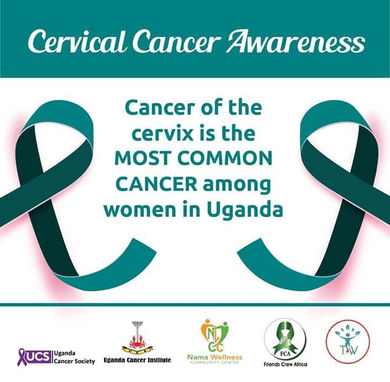Early Detection and Treatment of Cervical Cancer
 |  |  |  |
|---|---|---|---|
 |  |  |  |
 |  |  |
In the developed world, cervical cancer is a diminishing disease; with widespread screening, precancerous lesions are diagnosed and treated early. The HPV vaccine also has the potential to eradicate the virus for future generations. In Australia, it is estimated that this will be the case by the middle of the century.
In Uganda, on the other hand, cervical cancer accounts for 20% of all new cancers, and 35% of all female cancers – 80% of these women present with very advanced disease. At RHHJ, we see the great importance of the cancer screening initiative as more than 45% of all women with cancer that are enrolled in our palliative care programme have cervical cancer (Feb 2020).
Almost all of these women come to us with very advanced diseases, and they are suffering. They have all of the awful, painful and degrading symptoms of advanced cervical cancer: not only tremendous pain, but fistulas, incontinence, heavy bleeding and offensive discharge. Too poor to afford diapers, these women are isolated in dark rooms, ashamed and afraid of the foul discharge and stains on their skirts, dresses and bedding.
RHHJ is able to help the women we have contact with, but there are many more out there, and many more women will be doomed to the same fate unless they are diagnosed and treated early for this awful disease.


The Harsh Reality: Both of these women had advanced cervical cancer, and at just 53 and 27 years old, both of them died from this completely preventable disease, leaving behind their children and families. The disease stripped them of their dignity, caused them immeasurable pain and suffering and it could have been prevented.
Knowing the extent of the problem and the almost non-existent access to screening and early treatment for cervical cancer in the Busoga Region, RHHJ started a free screening programme in 2018, targeting the rural population and using the WHO recommended VIA test (Visual Inspection with Acetic Acid).
In 2018, we screened 265 women in the Busoga Region – 10% of who had cancerous or precancerous legions, and who we supported for further treatment. In 2019, we screened 1,264 women in the Busoga region – 8.8% of who tested positive and were supported with further treatment. If women test positive for precancerous cells, they are treated on-site with cryotherapy or thermotherapy, or referred for biopsies if the cells appear to be cancerous. We plan to further expand this programme in the coming years.
We also screen for breast cancer, teach women how to self-examine and treat other infections that they may have on-site. In this way, we hope to prevent many cases of advanced cancer and promote overall women’s health in the Busoga Region.

About 1 in 9 women in the Busoga Region test positive for precancerous cells, so at least one of these women is expected to develop cervical cancer if she is not treated.








